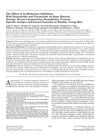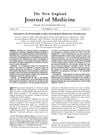TLDR Testosterone therapy may help men with osteoporosis.
The document discussed the role of testosterone therapy in preserving musculoskeletal health in men, particularly in the context of osteoporosis. It highlighted that testosterone was the androgen most strongly associated with musculoskeletal health. Although epidemiologic studies suggested that blocking the conversion of testosterone to dihydrotestosterone (DHT) might increase fracture risk, clinical trial data did not support this association. The focus was on understanding how testosterone therapy could potentially benefit men with osteoporosis.
 72 citations
,
April 2008 in “The Journal of urology/The journal of urology”
72 citations
,
April 2008 in “The Journal of urology/The journal of urology” Dutasteride and finasteride do not significantly affect bone density, blood fats, or blood production, but slightly lower PSA levels and minimally impact sexual function in healthy young men.
 417 citations
,
February 2004 in “The Journal of Clinical Endocrinology and Metabolism”
417 citations
,
February 2004 in “The Journal of Clinical Endocrinology and Metabolism” Testosterone therapy increases bone density in older men with low testosterone levels.
 11 citations
,
May 2002 in “The Journal of Urology”
11 citations
,
May 2002 in “The Journal of Urology” Finasteride doesn't harm bone density in older men with BPH.
37 citations
,
May 2002 in “PubMed” Finasteride does not harm men's bone health.
209 citations
,
March 1998 in “Biochemical and biophysical research communications” Scientists found new nonsteroidal compounds that can act like natural male hormones and might help treat male fertility and hormone issues.
 48 citations
,
November 1992 in “Clinical Endocrinology”
48 citations
,
November 1992 in “Clinical Endocrinology” Long-term finasteride use doesn't change bone density or metabolism.
 1040 citations
,
October 1992 in “The New England Journal of Medicine”
1040 citations
,
October 1992 in “The New England Journal of Medicine” Finasteride effectively treats BPH but may increase sexual dysfunction risk.
31 citations
,
October 1971 in “Steroids” Human beard hair follicles change testosterone into other related hormones, but don't much change androstenedione into testosterone.




